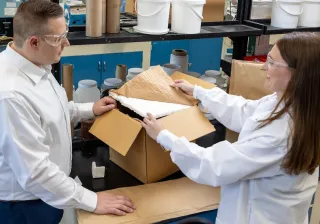The chair is the world's first innovation that utilizes foam forming technology, combines natural cellulose fibres, wood pulp and thermoplastic components, and represents a sustainable alternative for furniture design.
The VTT Technical Research Centre of Finland and ISKU, a leading Finnish furniture manufacturer, have joined forces to create a new kind of chair that showcases the potential of biocomposite materials. The chair is made from a cellulose-plastic compound that uses natural annual fibres, polypropylene and wood pulp from Finnish forests as raw materials.
“The biocomposite material was produced by VTT using foam forming technology, which was originally developed for papermaking. The process allows for high-volume and cost-efficient production and provides nearly limitless options for product customisation. Unlike conventional methods, we maintain the fibre properties and can get full reinforcing potential,” says Miika Nikinmaa, Biomaterial Solutions Lead at VTT.
“Once the process is optimised, we expect to be competitive even with extrusion technologies. In a previously published paper, we estimated that production costs would be 26% lower than with conventional technologies, but these figures will become more accurate as development continues.”
The material has excellent mechanical properties and can be 3D moulded into challenging shapes, making it optimal for lightweight structures. The thermoplastic composite can also be worked on with ordinary woodworking tools, making it a great drop-in solution for the furniture industry.
A unique design with environmental benefits
The chair, designed by ISKU, has a sleek and modern appearance that highlights the natural texture and colour of the biocomposite material.
“Our aim isn't merely to replicate existing products using new materials, but to pioneer innovative solutions that address unique customer needs previously unmet on the market,” says Mikko Porter, Head of Lean Six Sigma at ISKU.
The chair is durable, lightweight, and easy to assemble. The biocomposite material can be recycled at the end of its life cycle, reducing the environmental impact of furniture waste.
A new opportunity for the furniture industry with many additional applications
The global biocomposites market is expected to grow to approximately 7.6 billion US dollars. The estimated average annual growth rate from 2023 to 2027 is 7.6% (BCC Research 2022).
The biocomposite chair is a revolutionary product for the furniture industry. The biocomposite material can be used to create various shapes and forms and can be combined with other materials such as metal or wood. The material also has potential for other applications, such as packaging, consumer goods and construction. VTT is actively working with partners to build a strong value chain for commercial exploitation in the coming years.
“VTT will work with partners to advance the technology and explore ways to bring this exciting technology to market in the future. The material is expected to become available to consumers in the medium to long term,” Nikinmaa says.
The chair is the result of a HiPer project financed by Business Finland that involved VTT, ISKU, CH Polymers, Koskisen, Metsä Fibre, NMC Cellfoam, Paptic Ltd, Sulzer, Valmet and Volar Plastic.
For more information
- For more information about the biocomposite material and the production process, contact HiPer project manager Miika Nikinmaa, VTT Biomaterial Solutions Lead, at [email protected] or +358 503441928.
- For more information about the biocomposite chair and its design, contact Mikko Porter, Head of Lean Six Sigma, ISKU, at [email protected] or +358 50 3024 262.
Global Biocomposites Market Growth Analysis Research Report (bccresearch.com)






